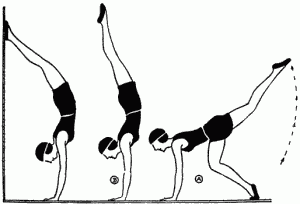 You won’t be surprised to read that from my perspective the psoas major is intimately involved with successful handstands. When working well the psoas major acts as a pulley system to help extend the spine to its full length— facilitating the erector muscles of the spine and aligning the head, neck and shoulders.
You won’t be surprised to read that from my perspective the psoas major is intimately involved with successful handstands. When working well the psoas major acts as a pulley system to help extend the spine to its full length— facilitating the erector muscles of the spine and aligning the head, neck and shoulders.
There are many ways to get up into handstands. Gymnasts tend to approach handstands from a standing position while in yoga we tend to be grounded and go up from downward dog—or for advanced practitioners from uttanasana, standing forward bend. We will look at kicking up into a handstand from downward dog.
Two prevalent tendencies limit people in their attempts to achieve handstands:
- The lifting leg and hip turn out and up when kicking up.
- The spine loses stability and arches too much.
A psoas major that works well creates a certain amount of tension as it crosses the rim of the pelvis. The psoas major attaches on the back half of the inner thigh, moves forward across the rim of the pelvis and goes back again to connect to the lower spine. This back, front, back setup is an important factor in the psoas majors ability to help the spine stay upright as well as get the spine over the arms into a handstand.
Developing movement that emanates from the core is the point of the practice. Engagement and employment of the psoas is the ultimate core connection—it is hard to achieve the stability we seek without getting in touch with our center.
To get up into a handstand, the leg that kicks should stay in the same plane as the trunk and hip. I actually pigeon toe the lifted leg a little to help this process. If my lifting leg stays lined up, the tension/pulley action brought to the psoas as I kick lengthens the spine with reciprocal inhibition making it easier to maintain a solid trunk and to lever the hips over the shoulders.
If my leg doesn’t stay in line as I kick, the hip and leg tend to turn open sideways. As soon as this happens all the tension that my psoas major brought to bear across the pelvis disappears. When this happens the spinal erectors that were extending the back of the spine lose their tone, and with the resulting loss of tone, the hips often move faster than the shoulders and the lower back arches excessively due to the loss of reciprocal inhibition that the engagement of the psoas major created.
A solid trunk and well aligned leg go together in cultivating successful handstands.
